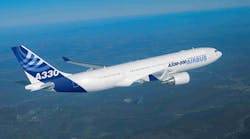Airbus SE is considering bringing the world’s first hybrid-electric airliner to market as it weighs its strategy for replacing the bread-and-butter A320neo narrowbody in the next 15 years— a move that would mark a technological leap for the aerospace industry.
The European planemaker has grown confident that the revolutionary propulsion system will be ready for roll-out on an all-new single-aisle jet around 2035, according to people with knowledge of its planning. While the company has been public about its interest in hybrid engines, Airbus is now willing to consider powering its most important aircraft with the technology, said the people, who asked not to be named discussing internal deliberations.
Timelines aren’t certain and will shift as different capabilities evolve, the people said, adding that Airbus would start with a smaller single-aisle and work its way up to a size comparable to the A321neo, which seats as many 240 people. Any decision to move forward would also take into account market dynamics and competition with global rival Boeing Co., they said.
Airbus is still pursuing a conventional replacement for its A320 family, which started service in the late 1980s to compete against Boeing’s then-market leading 737. It is studying using redesigned wings, more composite materials, and tweaks to current engine architectures with higher bypass ratios to get to the 20% boost to fuel efficiency needed to justify an all-new aircraft. It has been earmarked as viable for production from 2030.
Though hybrid technology probably won’t be available until a few years later, Airbus is confident that airlines would be prepared to wait for the step-change in efficiency that a hybrid would provide, according to the people, (airbus has targeted reducing CO2 emissions by 75% by 2050). The decision will in part come down to whether Boeing decides to accelerate its own clean-sheet narrow-body design in the wake of the 737 Max crisis that has seen that aircraft grounded since March, they said.
Airbus has been working with Rolls-Royce Holdings Plc and Siemens AG on developing a hybrid engine, though that powerplant, due to be tested in the next two years, would develop 2 megawatts of power, far less than needed to propel even a small narrow-body model.
A spokesman for Airbus said its current narrow-body offering still has scope for further developments, while adding that Chief Executive Officer Guillaume Faury indicated last month that the planemaker is exploring hybrid options for future aircraft.
“For short range, there are many many different options. We’re not alone, we have to keep an eye on what the competitors are doing,” Airbus Chief Technology Officer Grazia Vittadini said in a May 22 interview at the planemaker’s headquarters in Toulouse, France. “We will have a new single-aisle at some point. Will it be green, will it be green-enabled? It will depend” on when it enters service.
The launch of a hybrid model, while the biggest advance in the industry for decades, would bring its own challenges, not least convincing airlines to back technology that might initially offer only limited range and capacity.
One design for a hybrid jet is to use a conventional engine mounted at the back of the plane to charge a battery, in addition to producing its own thrust. That would enable electric propulsion on each wing, augmenting power during takeoff and landing -- by far the most fuel-guzzling parts of a flight. The aircraft would operate at slightly lower speeds, adding, for example, about 30 minutes to a typical flight within Europe.
Carbon Footprint
An upswell in development of hybrid and battery-electric aircraft coincides with rising consumer awareness of the carbon-dioxide impact of jet emissions. The planes being shown now, however, are much smaller than the Airbus and Boeing narrow-bodies that form the backbone of regional travel across the globe.
Airbus is ultimately working toward a zero-emissions aircraft, though given the relative immaturity of the technology it’s likely to have to develop a hybrid model first, head of engineering Jean-Brice Dumont said at the May briefing.
A shift to electrical power would be disruptive for the manufacturing process, since propulsion would become more integral to the aircraft’s construction. Vittadini ruled out producing batteries but said management systems, heat exchangers and even the engines themselves could be within Airbus’s capabilities.
Most other developments are focused on smaller aircrafts. Zunum Aero, backed by Boeing and JetBlue Airways Corp., aims to bring a hybrid-electric commuter model to market by 2022. MagniX Technologies Pty Ltd. is developing a propulsion system for an all-electric plane with a similar date in mind. Israeli startup Eviation is also going fully electric, with a nine-passenger plane making its debut at the Paris Air Show next week.




